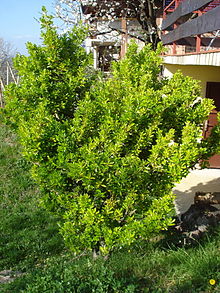You are here
被子植物
Euonymus japonicus Thunb.
EOL Text
Euonymus japonicus (evergreen spindle[1] or Japanese spindle) is a species of flowering plant in the family Celastraceae, native to Japan, Korea and China.[2] It is an evergreen shrub or small tree growing to 2–8 m (6 ft 7 in–26 ft 3 in) tall, with opposite, oval leaves 3–7 cm long with finely serrated margins. The flowers are inconspicuous, greenish-white, 5 mm diameter. In autumn, orange fruit hangs below the flaring pink seed coverings.
Horticultural cultivars[edit]
Euonymus japonicus is a popular ornamental plant for parks and gardens, both in its native area and also in Europe and North America. In particular the numerous cultivars which have been selected (often with variegated or yellow leaves) are widely grown in all soil types in sun or shade. Some of the more distinctive cultivars are:
- 'Albomarginatus' - leaves green, narrowly margined white
- 'Bravo' - green and creamy-yellow variegated leaves, upright habit
- 'Chollipo'agm[3]
- 'Green Spire' - evergreen columnar narrow shrub
- 'Kathy' - green and white variegated, broad leaves, shorter growing than most
- 'Latifolius Albomarginatus' - green leaves with broad white margin
- 'Ovatus Aureus'agm[4]
- 'President Gauthier' - dark green and creamy-white variegated leaves, slightly more lax habit than others
(those marked agm have gained the Royal Horticultural Society's Award of Garden Merit)
References[edit]
- ^ "BSBI List 2007" (xls). Botanical Society of Britain and Ireland. Retrieved 2014-10-17.
- ^ Phillips, R. and Rix, M., "Shrubs", Macmillan, 1994, p271
- ^ "RHS Plant Selector - Euonymus japonicus 'Chollipo'". Retrieved 19 June 2013.
- ^ "RHS Plant Selector - Euonymus japonicus 'Ovatus Aureus'". Retrieved 19 June 2013.
| This Celastraceae article is a stub. You can help Wikipedia by expanding it. |
| License | http://creativecommons.org/licenses/by-sa/3.0/ |
| Rights holder/Author | Wikipedia |
| Source | http://en.wikipedia.org/w/index.php?title=Euonymus_japonicus&oldid=632986098 |
This species is a native of Japan, and it is from here that the cultivated form was introduced to the world. Euonymus japonicus, especially in the cultivated condition, is very similar to E. fortunei. The native species differs by having an erect habit vs. climbing or procumbent in E. fortunei. Ding Hou used the name E. japonicus (Fl. Males., Ser. 1, Spermat. 6: 252. 1963) to represent the taxa in S and SE Asia; however, it is E. fortunei that is native to this region, while E. japonicus is only cultivated in the area.
| License | http://creativecommons.org/licenses/by-nc-sa/3.0/ |
| Rights holder/Author | eFloras.org Copyright © Missouri Botanical Garden |
| Source | http://www.efloras.org/florataxon.aspx?flora_id=2&taxon_id=200012806 |
"Notes: Western Ghats, Cultivated, Native of East Asiatic Region"
An ornamental plant, cultivated in gardens in the plains and the hills for its beautiful foliage.
| License | http://creativecommons.org/licenses/by-nc-sa/3.0/ |
| Rights holder/Author | eFloras.org Copyright © Missouri Botanical Garden |
| Source | http://www.efloras.org/florataxon.aspx?flora_id=5&taxon_id=200012806 |
Tamil Nadu: Dindigul
Anhui, Fujian, Gansu, Guangdong, Guangxi, Guizhou, Hainan, Hebei, Henan, Hubei, Hunan, Jiangsu, Jiangxi, Liaoning, Qinghai, Shaanxi, Shandong, Shanxi, Sichuan, Taiwan (Lan Yu), Xinjiang, Yunnan, Zhejiang [native to Japan; cultivated in Cambodia, India, Indonesia, Korea, Laos, Myanmar, Pakistan, Philippines, Thailand, Vietnam; also cultivated in Africa, Europe, North America, Oceania, South America].
| License | http://creativecommons.org/licenses/by-nc-sa/3.0/ |
| Rights holder/Author | eFloras.org Copyright © Missouri Botanical Garden |
| Source | http://www.efloras.org/florataxon.aspx?flora_id=2&taxon_id=200012806 |
Chile Central
| License | http://creativecommons.org/licenses/by-nc-sa/3.0/ |
| Rights holder/Author | Pablo Gutierrez, IABIN |
| Source | No source database. |
Distribution: Native of China and Japan.
| License | http://creativecommons.org/licenses/by-nc-sa/3.0/ |
| Rights holder/Author | eFloras.org Copyright © Missouri Botanical Garden |
| Source | http://www.efloras.org/florataxon.aspx?flora_id=5&taxon_id=200012806 |
Evergreen shrubs or small trees, erect, to 3 m tall, sometimes dwarfed; branches gray-green to gray-brown, terete, glabrous, sturdy, twigs green to light green, glabrous, not evidently striate, especially when fresh. Petiole 3-10 mm; leaf blade leathery or thickly leathery, ovate, obovate, orbicular-ovate, or long ovate, (3-)5-10(-12) × (2-)3-5(-5.5) cm, base orbicular or semiorbicular, margin crenulate distally, nearly entire proximally, apex orbicular or semiorbicular; lateral veins 6-8 pairs, slightly visible or unclear, especially when dry. Cymes usually axillary, sometimes terminal, many branched with many flowers; peduncle up to 8 cm, sub-branches 2-4 cm; pedicel 4-7 mm. Flowers 4-merous, 5-6 mm in diam.; sepals nearly orbicular; petals green or yellowish green, sometimes cream, nearly orbicular. Capsule globose or subglobose, brown or yellow-brown to red-brown, 6-9(-12) mm in diam., 4-lobed. Seeds 2 per locule, dark brown, globose; aril orange-red. Fl. Apr-Aug, fr. Aug-Jan.
| License | http://creativecommons.org/licenses/by-nc-sa/3.0/ |
| Rights holder/Author | eFloras.org Copyright © Missouri Botanical Garden |
| Source | http://www.efloras.org/florataxon.aspx?flora_id=2&taxon_id=200012806 |
An evergreen, glabrous shrub or a small tree, 1-3 (-6) m tall. Leaves opposite, 2-7 x 1-4 cm, obovate, spathulate, ovate or orbiculate, cuneate, obtuse or acute, leathery, bright green above, pale beneath, crenate; crenations bearing stiff hairs. Flowers tetramerous, greenish-white, 3-4 mm in diameter, 5-12 in cymes up to 5-10 cm long. Calyx lobes orbicular. Petals broadly ovate to elliptic. Capsule 3-7 mm broad, globose, pinkish, slightly lobed, usually with an apical persistent style; seeds covered with a scarlet aril.
| License | http://creativecommons.org/licenses/by-nc-sa/3.0/ |
| Rights holder/Author | eFloras.org Copyright © Missouri Botanical Garden |
| Source | http://www.efloras.org/florataxon.aspx?flora_id=5&taxon_id=200012806 |

